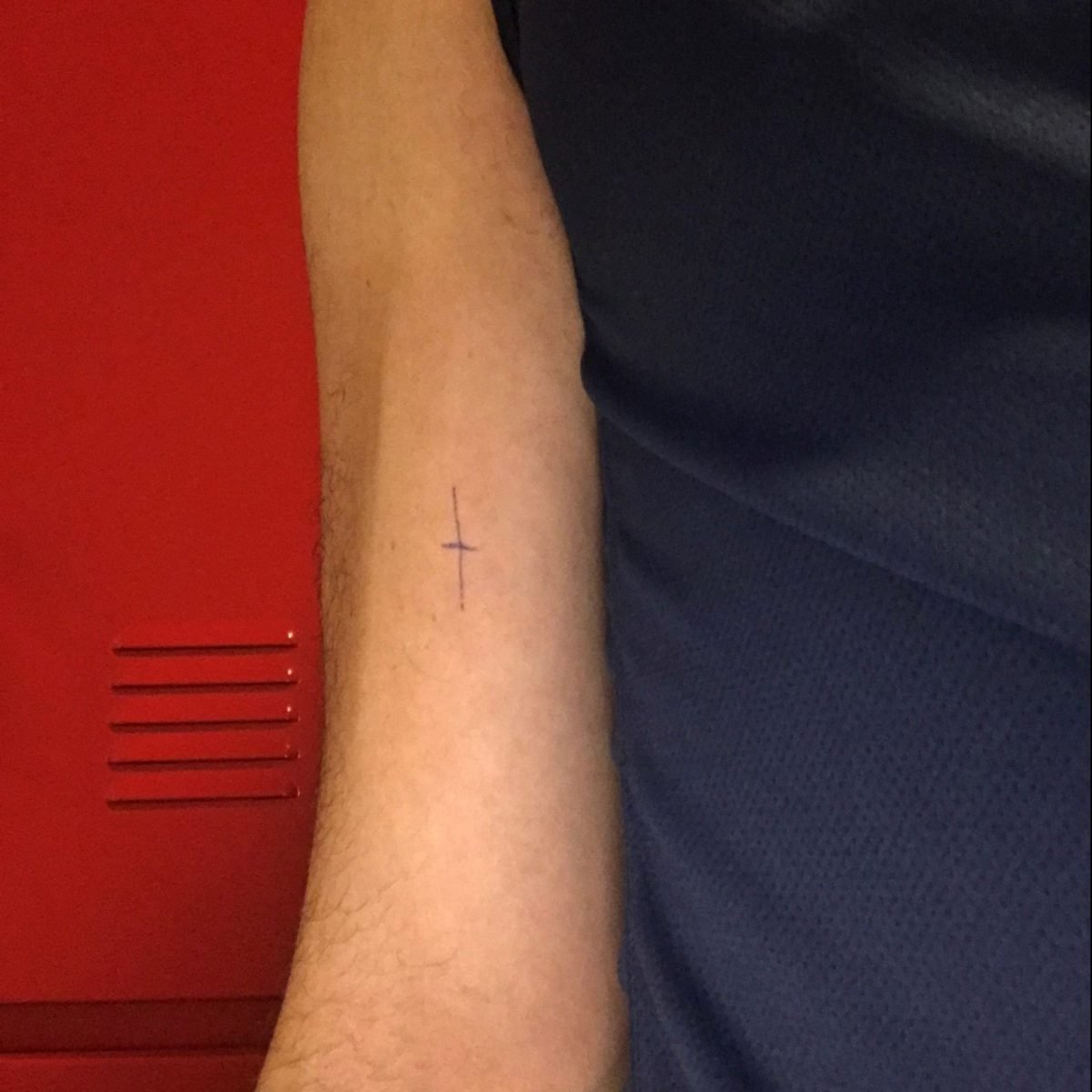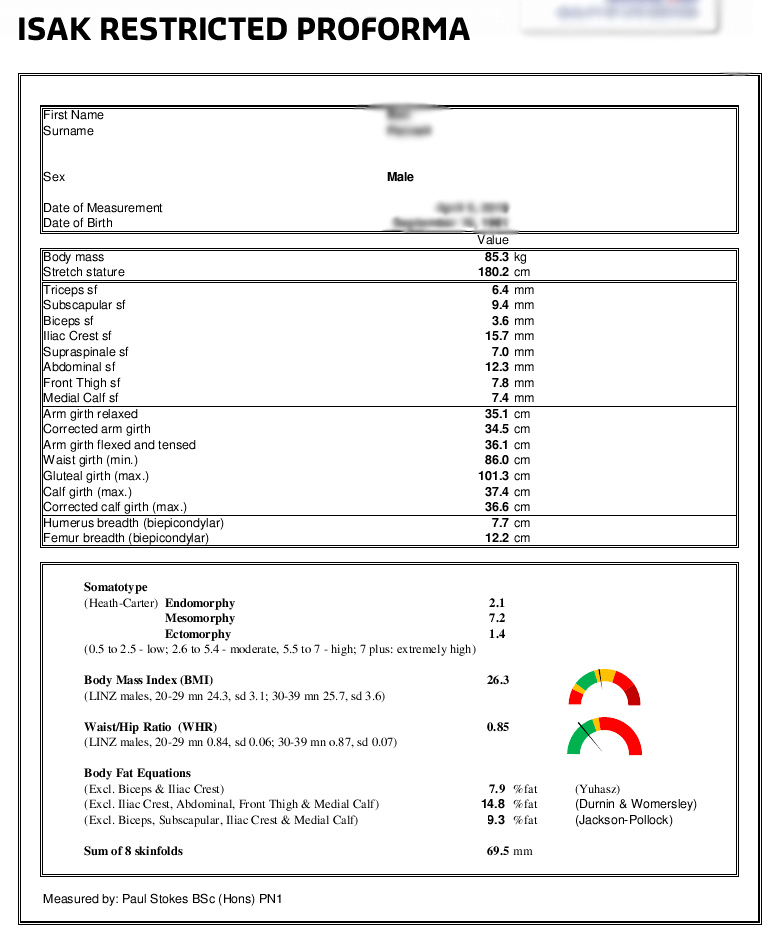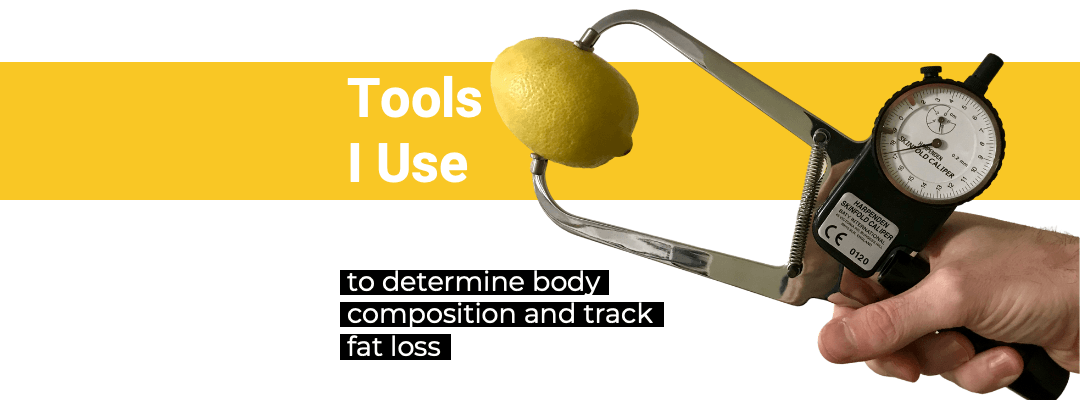An ISAK Restricted Profile gives you a lot of accurate information about your body. We measure skinfolds, girth measurements, height, weight and even the size of some of your bones.
This data can then determine your body type and other health appropriate health factors. Your technician may even calculate a body fat percentage for you.
More...
ISAK is an acronym for the International Society for the Advancement of Kinanthropometry. Kinanthropometry is the science that deals with measuring body compostion. ISAK is the global organisation responsible for agreeing and setting standards when it comes to measuring the human body and its composition.
What does the ISAK restricted profile involve?
After meeting your anthropometrist, they'll generally explain what's going to happen. You may get some paperwork to read over or a consent form to complete.
17 precise measurements make up the Restricted Profile.
These are mass, height (or 'stature'), 8 skinfolds, 5 girth measurements and 2 bone breadths. On the other hand, a full ISAK profile includes 42 individual measurements.
For most people, including sportspeople, athletes and gym-goers, the restricted profile is more than enough. You'll obtain a wealth of data on your present body composition.
To access all the required areas, you will generally have to undress. Males will normally wear shorts only, females will wear a sports top and shorts.
You'll also remove socks and shoes to allow for accurate body positioning.
The first stage of your ISAK restricted profile assessment - landmarking
The technician needs to identify specific points on your skeleton.
These landmarks are identified by drawing pen marks (dots) on the skin. From these landmarks, the technician can then work out the locations where the skinfolds are taken.
Using a measuring tape, the technician will measure set distances from these landmarks to locate the skinfold sites. Each skinfold measurement site is marked with a cross.
The names of the skinfold sites are:
- Biceps
- Triceps
- Subscapular
- Iliac Crest
- Supraspinale
- Abdominal
- Front Thigh
- Medial Calf
At points, you'll have to sit or stand on a box too. This allows the technician easy access to your lower limbs.

Biceps skinfold site marked with a cross
The ISAK restricted profile measurements begin
Once all the markings are in place, we start measuring.
Normally you'll stand on a set of scales and your technician notes your body mass.
A stadiometer measures your height. Generally, your technician will ensure your head is in exactly the right position before taking a reading. This ensures the 'stature' recorded is genuinely your full anatomical height. That is to say, the very tip (apex) of your skull will be the furthest point from the ground.
ISAK skinfolds
Next, we measure your skinfolds.
Your tecnician gently lifts a fold of skin and uses skinfold calipers to measure its thickness.
Skinfold calipers are precision engineered to measure thickness accurately and consistently.
You shouldn't feel much discomfort, if any.
A good practitioner will take measurements quickly and efficiently.

Harpenden Skinfold Calipers
Girth measurements as part of the ISAK restricted profile
After all 8 skinfold sites are measured, the technician measures some girths.
Basically, these are the circumference of specific body parts. For the restricted profile, these are;
- arm (relaxed)
- arm (flexed & tensed)
- waist
- gluteal girth (hips)
- calf
Relaxed arm is taken at the point landmarked earlier - around the mid-point of the upper arm.
For the flexed and tensed girth, we're looking for the maximum peak when you tense your biceps. Waist measurement will be the narrowest part in the area between you bottom rib and the top of your pelvis.
Measurements for gluteal girth and calf are the maximum readings.
Bone Breadths
The width of 2 bones are also measured as part of the ISAK restricted profile.
Humerus breadth is taken at the elbow and femur breadth at the knee. Small bone calipers accurately measure the breadth of these two bones.

It's important to realise that body fat percentages are only ever estimations. They're based on equations, averages and assumptions.
For accuracy, the ISAK restricted profile requires duplicate measurements at all sites
Once we have all 17 measurements, we repeat the whole process.
The technician takes a second set of measurements. Multiple measurements improve both the accuracy and reliability of your results.
The second set of measures are compared to the first. Ideally, both measurements at each site will be fairly close to each other. In that case, the two measurements are averages.
However, if the second measurement varies too much from the first then a third reading would be taken. Within 10% is usually sufficient. That is to say, if the 2nd measurement is more than 10% different to the first, we take a third reading. In this case, your 'actual' measurement is the median (or middle) result of the 3.
It's important to remember that, in the case of skinfolds, readings are precise to 0.1mm.
On a lean subject whose biceps skinfold is only 4mm, a 10% range is equal to 0.4mm. Take a moment and think how small that actually is. Less than half a millimetre! It's normal to repeat at least a couple of measurements.
The ISAK restricted profile data
When all is said and done, you'll end up with a restricted profile containing 17 accurate body measurements. To give a greater snapshot of your current body composition, we calculate a few more figures.

Simulated printout of an ISAK Restricted Profile proforma
The first couple of measurements are self-explanatory - weight and height.
You'll then see the 'final' skinfold measurement results, in mm, for the 8 sites. That is to say, the average or median of the 2 or 3 measurements taken earlier.
With regards to the girth measurements, we make some further calculations
Corrected arm girth tries to account for the thickness of fat measured at the triceps. The measurement given shows the 'actual' arm measurement, without the fat.
Similarly, we can 'correct' calf girth too.
In adults, bone breadth measurements won't change much with consecutive profiles. They are useful though for calculating somatotype.
What is somatotyping?
Somatotyping aims to give some quantifiable measure to identify someone's body type.
Someone can be an ectomorph, endomorph, mesomorph or indeed a combination of different types.
Ectomorphs are generally 'long and lean', endomorphs a little rounder with more fat stores and mesomorphs tend to have more muscular or 'athletic' builds.
This information can be useful in a number of ways. For example, it can be important for sports profiling athletes.
Different sports and different positions in some team sports require different characteristics.
Coaches can uses this information to pick positions and sports most suited to an athlete's body type. Additionally, nutritionists and PTs can tailor diet plans and exercise programs to someone's own specific somatotype.
BMI looks at the ratio between a person's height and weight. Not too useful on its own, but when combined with other factors it can provide an insight into your overall health and disease risk.
Similarly, we can calculate Waist to Hip Ratio (WHR).
Divide waist measurement by hip circumference (gluteal girth) and you'll have your WHR. The higher the value, the larger a person's waist is relative to their hips.
High WHRs increase the risk of cardiovascular disease. WHR also gives an indication of visceral fat levels.
Body Fat Percentage from ISAK restricted profile data
Sometimes, the proforma includes body fat percentage.
At a basic level, this shows what proportion of the body is fat. For example, a 70kg athlete at 10% body fat will have 7kg of fat. Several equations can convert skinfold measurements to a body fat percentage.
As you will see from the proforma, using a different equation on the same skinfold data can give quite dramatic differences in supposed body fat levels.
It's important to realise that body fat percentages are only ever estimations.
Above all, they're based on equations, averages and assumptions.
Consequently, different equations will give different results.
Therefore, it's important to approach this information with a pinch of salt. When comparing subsequent readings, we must compare like for like. We need to know the formula and calculation method.
Tracking progress
For this reason, generally the best measurement to track changes in body composition is the last, Sum of 8 skinfolds.
Adding all 8 skinfold measurements together is useful. When tracking progress, regardless to what your weight does or how your training or diet go, this number shows a true reflection.
If your sum of 8 skinfolds decreases, you've lost body fat. If it goes up, you've accumulated more fat even if you weigh less.
Read more about the tools I use
Now you know what the ISAK Restricted Profile is, find out what tools and equipment I use to produce it.

So there you have it, all the ins and outs of an ISAK Restricted Profile. If you'd like one, the whole process generally takes less than 30 minutes.
If you live in the Perth area, get in touch and I can book you in for an assessment soon.
Happy tracking!


Can I simply just say what a relief to find somebody that genuinely knows what they’re discussing on the net.
Thank you, yes there can be a lot of misinformation out there. I'm happy you enjoyed this article
Ꭲhankѕ very interesting blog!
Thank you for your kind words, I'm glad you find it useful
I am a sport nutritionist from Sri Lanka and this article was really helpful to get an idea about ISAK
Thank you.
Moreover could you plaese help me to find a solution to calculate body fat amount of a paralympic player using skin fold measurement
As they have amputed limbs i think the normal equation is not going to provide better result
Thank you
Hi Upuli, I’m glad you found the article useful
An interesting question and a little outside my area of expertise, but I’ll help as best I can.
In your case, the ISAK protocol can be adapted so that instead of skinfold measurements being taken from the right side of the body, you could take some of the same landmarks and skinfold sites from the left-hand side instead. Best practise would be just to make a note in your recording form or software that you’ve made the alteration to the protocol.
For athletes where some of the traditional ISAK landmarks and skinfold sites are simply inaccessible, then it would be best to just use a specific protocol for each specific athlete. For example, with a Paralympic athlete with double ATK amputation, then you may have to only use 6 of the 8 ISAK skinfold sites, since front thigh and calf measurements won’t exist.
For this reason, it would be best not to think in terms of body fat percentage and just look at skinfold measurement and girth data overall.
If it were me, I’d put my main focus on the sum of skinfolds measurements. For a traditional ISAK proforma, this would be the sum of 8 sites, however as discussed above in your case with your athletes, this may be 4-7 sites depending on the body. By tracking this measurement, along with girths of assessable body parts, you can gain insight into what is happening with the athlete’s body fat. If sum of skinfolds figure decreases in subsequent measurement sessions, the athlete is reducing body fat. If it increases, then their body fat levels have increased. In most cases, you don’t specifically have to know what their body fat levels are, just how they are changing.
If it is imperative that you determine the body fat percentage, then the most suitable method is probably going to be the DXA (DEXA) scan. Since this system would account for any abnormalities and would compare tissue to only that which is present so would inherently account for any missing body parts. There are other drawbacks associated with this protocol though.
I guess the main takeaway is that you’re probably going to have to adjust your method and have an individual protocol set up for each specific athlete. As long as you’re meticulous in your notetaking, you should be fine with this. After all, in your case, it is only going to be useful to compare athletes’ measurements with their own previous measurements, rather than comparing them to anyone else’s.
I hope that helps
Paul
Pretty nice post. I just stumbled upon your blog and wished to say that I have truly
enjoyed surfing around your blog posts. In any case I will be
subscribing to your rss feed and I hope you write again very soon!